I have been trading cryptocurrencies for 10 years, starting from 50,000 and growing to 28 million.
I want to earn my first 1 million in the cryptocurrency world, and I can only use this method with a small principal. I want to earn my first 1 million in the cryptocurrency world, and I can only use this method!
If you have enough capital, then making 1 million is not difficult at all. If the capital is really too small, the only thing I can help you with is contract rolling*. Typically, if a popular coin rises by 30% in a single day, and you only have a small amount of 50 to 100 dollars, you can choose to go long with 20x leverage at a low point and continuously roll over profits (i.e., reinvest profits).
If the day's increase really reaches 30%, your profit could be between $5000 and $10000. For example, recently strong-performing coins like turbo, not, and people are very suitable for rolling operations.
However, 20x leverage carries higher risks; even slight market corrections can lead to losses. Therefore, using 10x leverage may be a better choice; while expected returns may decrease, the margin for error will significantly increase.
Once you successfully roll over, even if mistakes occur later, your losses are limited to the initial $50. If you have a certain market sense or skills, and you're lucky, you may even double that $50. Conversely, if you lack luck and skills, even $500 million could be lost entirely.
Therefore, even if you start with trial and error, you only need to invest $50 instead of blindly throwing in a large amount of money.
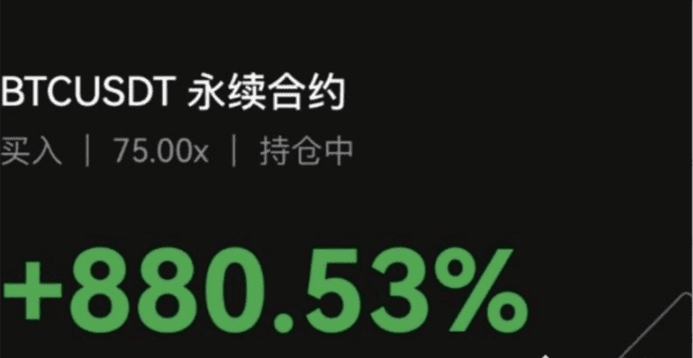
Investment mindset and strategy
Mindset is paramount: Stay patient and calm, think rationally, and do not be swayed by emotions. Clear strategy: Determine entry and exit points before entering; this is key to sound investing. Breakthrough entry: Get used to entering on volume breakouts with pullbacks to reduce risk, focusing on major mainstream coins.
Investment tips.
Long-term weekly: Not only look at daily charts, but also pay attention to weekly charts, stripping bottom coins; holding coins for a long period can also yield profits.
Pullback opportunities: Opportunities often arise during pullbacks; do not fear pullbacks, as they are good times to buy.
Reverse thinking: When others are enthusiastic, we remain calm; when others abandon, we look for opportunities; counter-trading often yields profits.
Quick and decisive: In short-term operations, if the trend does not align with expectations within three days, exit decisively; if losses reach 20%, stop loss unconditionally.
Investment principles.
Go with the trend: The price of coins is not necessarily better the cheaper it is; the entry point is key.
Learn to follow trends, embrace trends, and trade new coins rather than old ones.
Abandon unpopular options:
Obscure coins carry high risks and unstable returns; you should learn to let go and focus on mainstream and promising coins.
Prices rise quickly and fall slowly; the dealer may be accumulating positions.
Coin prices soar upward, but when they fall, it’s slow; this may indicate that the dealer is secretly accumulating positions, preparing for another big push.
Prices drop quickly and rise slowly, beware of the dealer offloading.
Prices drop quickly, but when they rise back, it’s as slow as a snail; this often indicates that the dealer is slowly offloading stock, and the market may be heading downhill.
Don't be anxious when volume increases at the top; run quickly when there's no volume.
When prices are sky-high, and volume increases, don't rush; it may rise further. But if volume decreases, then you must hurry to withdraw; it won't move up anymore.
Take a closer look when there's volume at the bottom; wait for sustained volume before taking action.
When prices drop to a low, and volume increases, don’t rush to buy; it might be a resting point for the decline. If volume remains high, it indicates that money is starting to flow in, and at this point, you can consider bottom-fishing.
Trading coins is about trading emotions; consensus reflects in trading volume.
Trading coins is about everyone's emotions; when emotions fluctuate, coin prices follow. Trading volume is a direct reflection of whether opinions align.
I specifically compiled [The Essential Tool for Retail Traders to Identify Trends: Structure Breakout (BOS) Strategy Analysis], sharing it with those destined to find it. Make sure to save it; remember to follow (Crypto Xunxun) as I will share more content later.
In trading, 'structure breakout' refers to price breaking through established highs and lows in a trend, clearly indicating the continued order flow in the current direction. This concept is crucial in trend analysis, helping traders understand market momentum and potential future direction.
In simple terms, this means forming higher highs (HH) in an uptrend rather than first forming lower lows (LL). This situation is called a bullish structure breakout. In a downtrend, a structure breakout occurs when lower lows are formed first, followed by higher highs, which is called a bearish structure breakout. In other words, structure breakout signals indicate the continuation of market momentum or market sentiment.
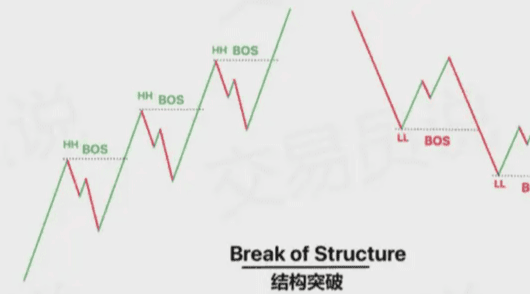
Order is important. A structure breakout occurs only in an uptrend when higher highs are formed without first breaking lower lows. In a downtrend, a structure breakout occurs only when lower lows are formed before breaking recent highs. If either of these situations occurs, we can consider it a market structure shift (MSS) or characteristic change (ChoCh).
Essentially, structure breakouts mean you've received the first signal indicating that the existing trend is weakening, and a reversal is imminent.
It's important to note that structure breakouts don't just occur in trending markets. When the price breaks through key support or resistance levels, established trend lines, or even certain chart patterns, it can also be considered a structure breakout.
Any situation where the market breaks through common structures can be considered a structure breakout. However, this article will focus on market structure breakouts in trending markets.
In this article, we will delve into structure breakouts, as they are the most fundamental concept in smart money trading.
Basic market structure.
Market structure refers to how prices change over time. There are mainly three types:
1. Uptrend: When prices continue to rise, you will see new highs being created without the price breaking previous lows.
2. Downtrend: In contrast to the uptrend, prices continue to decline, creating new lows, and prices will not break through previous highs.
3. Range-Bound: In this case, prices fluctuate up and down within a certain range but do not create new highs or lows.
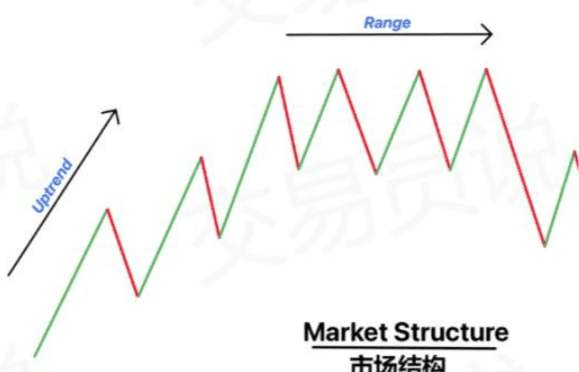
The concept of 'structure breakout' is actually only meaningful in uptrends and downtrends. It occurs when prices break through significant highs in an uptrend or significant lows in a downtrend. This is a signal indicating strong trends that may continue. However, in range-bound markets, prices do not create new highs or lows, so structure breakouts are not applicable.
Types of structure breakouts.
Based on direction and the nature of the breakout, there are two types of structure breakouts:
Bullish structure breakout (Bull BoS):
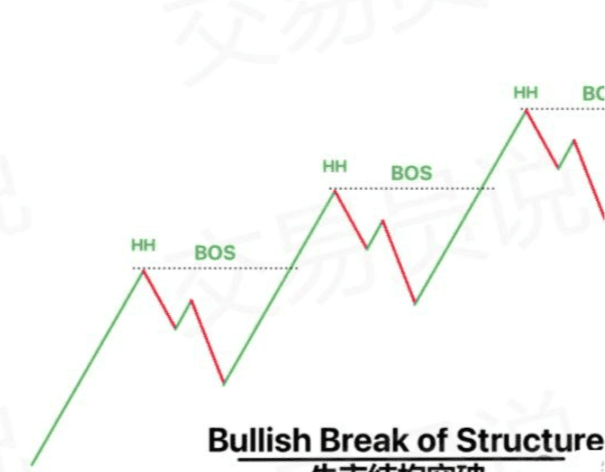
When the price breaks through the volatility highs in a trend, it indicates strong upward momentum and suggests that the bull market (uptrend) may continue.
Bearish structure breakout (Bear BoS):
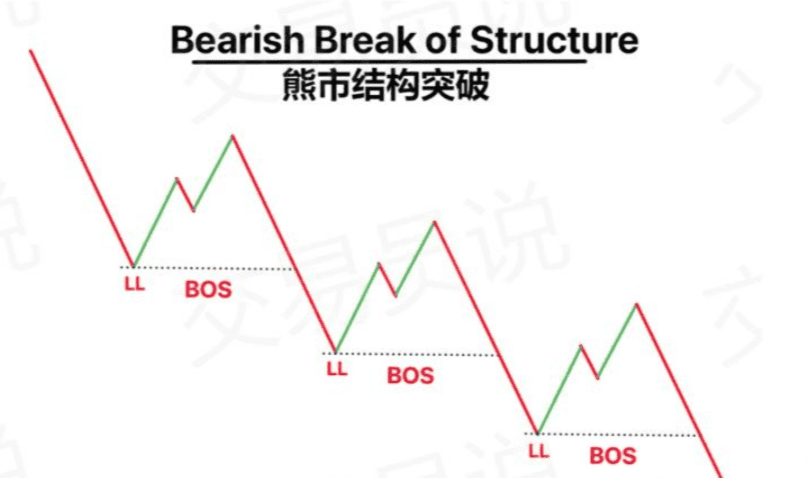
Conversely, when the price breaks through volatility lows, it signifies strong downward momentum and may indicate that the bear market (downtrend) continues.
The difference between bullish and bearish structure breakouts.
The bottom distinguishes between bullish structure breakouts and bearish structure breakouts:

Significance.
"Structure breakouts" help predict whether the market will continue its current trend or reverse direction. This insight has several important aspects:
1. Predict market direction:
By identifying structure breakouts, traders can predict whether the current trend will continue or if the market is about to reverse. This understanding can help align their strategies with the potential future market movements.
2. Collaborate with market makers in trading:
Identifying confirmed structure breakouts enables traders to align their trades with market makers' operations. When a structure breakout confirms a trend continuation, traders can more easily and confidently trade in that direction.
3. Seize entry and exit opportunities:
Structure breakouts can also serve as important signals for seizing market entry and exit opportunities. For example, a bullish structure breakout indicates a good entry point in an uptrend, while a bearish structure breakout may be a favorable time to exit or establish a short position.
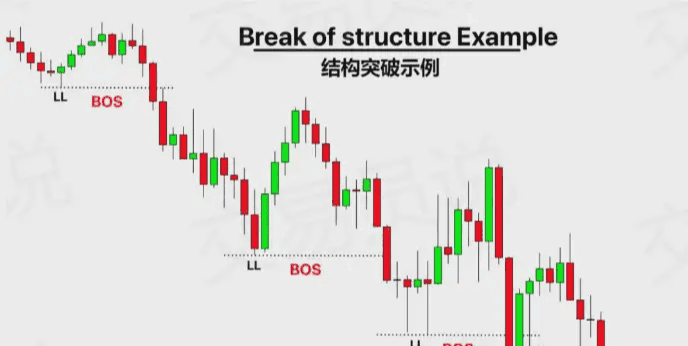
Overall, understanding and utilizing structure breakouts not only enhances the ability to predict market trends but also aligns trading strategies with the powerful forces driving market fluctuations, thereby increasing the potential for successful trades.
How to apply structure breakouts in trading?
Effectively trading structure breakouts requires combining them with other strategies to improve the accuracy of predicting future price direction. Here is a simplified explanation of how to combine structure breakouts with moving averages and candlestick pattern strategies:
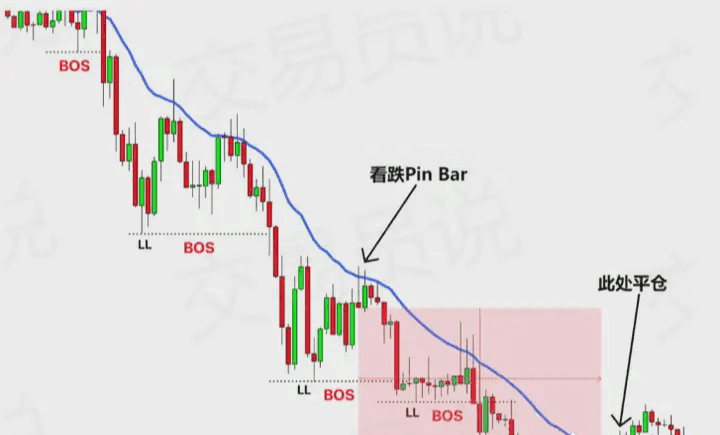
1. Set up.
First, identify lower lows and lower highs in a downtrend. Add a 21-period Exponential Moving Average (EMA) to the chart.
2. Identify structure breakouts.
When the price breaks below these lower lows, a structure breakout occurs. This indicates that the price may continue to move downward.
3. Execute sell trades.
After a bearish structure breakout occurs, wait for a bearish candlestick pattern to form, such as a bearish engulfing pattern or a Pin Bar. This is your signal to enter a sell trade.
4. End of trading.
Monitor the relationship between price and EMA. When the price breaks through EMA, it indicates that the trend may change or momentum may be lost, at which point you can close your positions.
Please remember, this strategy is just an example to help you understand how to incorporate structure breakouts into trading. The important thing is to develop and test your strategy based on your own trading style and risk tolerance. Incorporating structure breakouts as part of a broader strategy can enhance the effectiveness of your trades by providing additional confirmation of market trends.
Case Study: Trading with bullish structure breakouts and demand zones
In this trade, we observed a clear bullish structure breakout (Bull BoS) in the market. When the price broke through a previous significant high, it indicated strong upward momentum.
Identifying bullish BoS:
◎ The market is in an upward trend, creating higher highs and higher lows.
◎ When the price breaks through the recent high, it confirms the bullish BoS, indicating that the uptrend may continue.
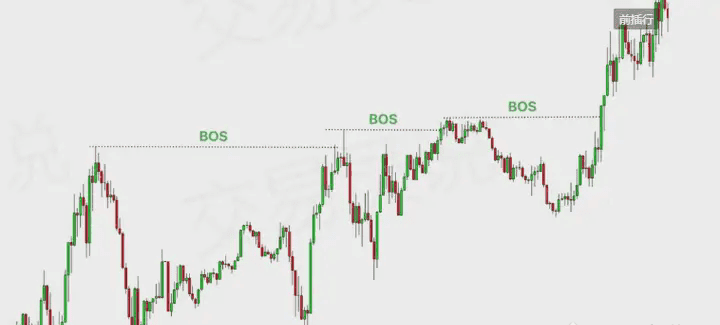
Formation of demand zones:
◎ After the bullish BoS forms, the price retraces to the breakout area, forming what is referred to as the demand zone.
◎ This demand zone is located near the area where the BoS occurred, making it a key level for potential order accumulation.
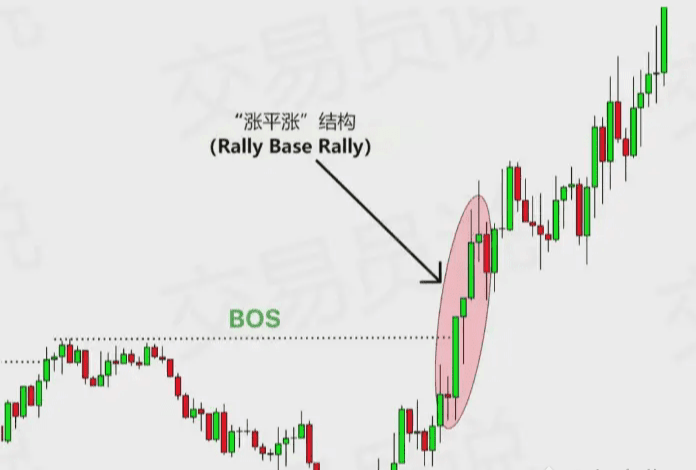
Trade execution:
◎ After observing price movements, wait for the price to return to this demand zone.
◎ As expected, the price entered the demand zone and began to show signs of order accumulation. This is my signal to prepare for a buying trade.
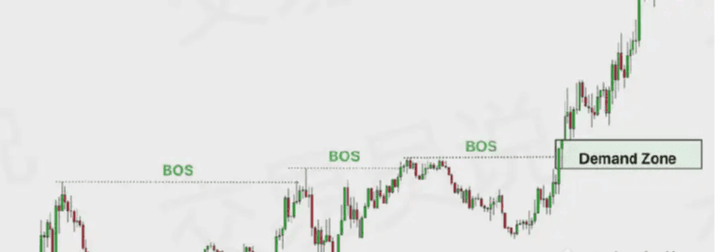
Trading results:
◎ After orders are filled in the demand zone, prices begin to fluctuate upward.
◎ This fluctuation confirmed my analysis, and I.
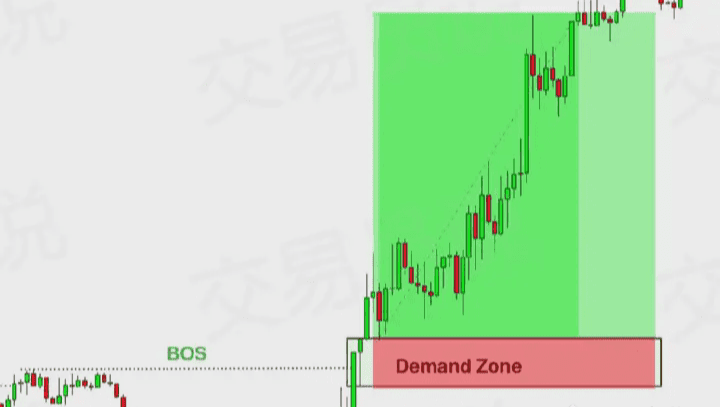
A buying trade was made under strong upward momentum.
◎ This trade offers a higher risk-reward ratio because the entry point in the demand zone provides a clear stop-loss level, and due to the confirmed upward trend, the upward potential is also considerable.
How to operate structure breakouts in foreign exchange trading?
In a bull market, when the price breaks through a structure, you should mark the incentive area (in price action trading, incentives are smart money traps that can take the form of order blocks, supply and demand zones, or support and resistance areas) and wait for the price to pull back to that area and rebound.
When the price touches the incentive area, you can look for confirmation signals for buy trades in lower time frames, such as market structure shifts (MSS) or trend reversals.
In a bear market, when the market breaks through a structure, you should mark out the incentive area and wait for the price to pull back to that area and rebound.
When the price touches the incentive area, you can look for confirmation signals for sell trades in lower time frames, such as market structure shifts (MSS) or trend reversals.
ICT MSS and BoS.
As we discussed earlier, structure breakouts indicate that after breaking the incentive area, previous structures (highs/lows) are breached.
The ICT market structure shift (MSS) indicates a breakthrough of volatility lows or volatility highs.
Thus, the difference between structure breakouts and changes in market structure lies solely in the incentive area.
Structure breakouts indicate significant changes in price trends, while changes in market structure indicate preliminary changes in structure.
You can refer to the image below to understand the difference between BoS and MSS:
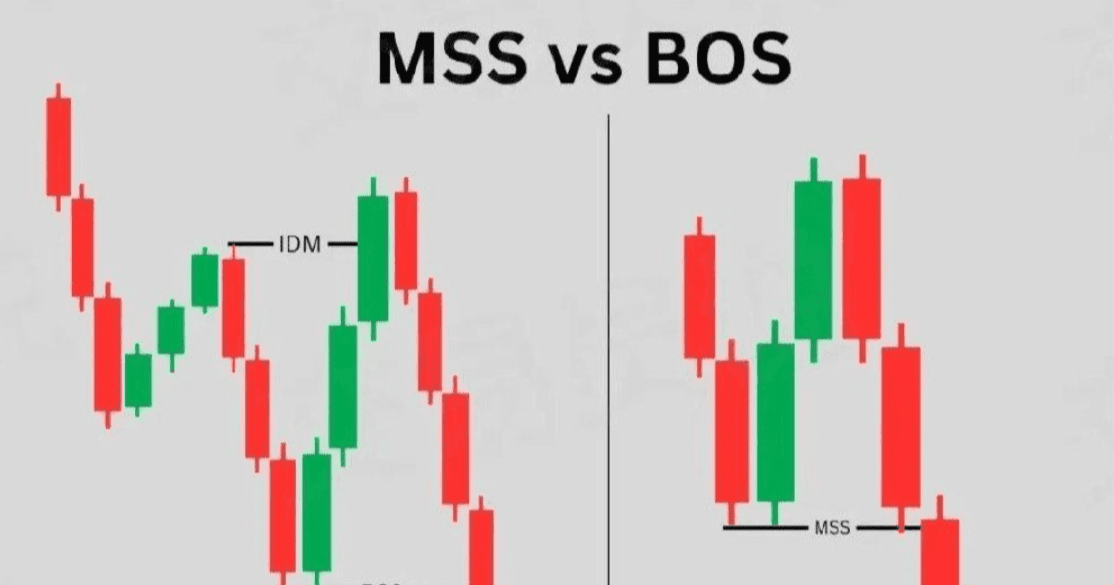
Conclusion.
Overall, 'structure breakout' is a very important concept in price action trading. It helps us determine whether the market will continue to rise or fall. We understand that combining structure breakouts with other tools (such as demand zones or candlestick patterns) can make our trading strategies more effective.
Remember, structure breakouts are a good guide, but they work best when combined with your own trading plan. The key is to better understand the market and make more informed trading decisions. Continuously practicing this concept will enable you to master how to leverage it in your trading to your advantage.
When using structure breakout strategies for trading, we must keep in mind that no strategy is foolproof, so do not invest all your account funds into this strategy.
Additionally, to reduce risk, you should always set stop losses to protect your principal.
Have you been trading coins for a year and still haven't reached seven figures? Let me teach you.
Have you been trading coins for a year and still haven't made a seven-figure profit? Don’t worry; here are 10 super practical tips. If you follow them and still can't make money, come find me! I genuinely hope to help everyone:
1. If you have little money, don't act recklessly. If your available funds are less than 200,000, wait for a significant price surge once a year; do not always think about going all in, as it is easy to lose everything.
2. We must understand how much we know about the crypto space, as it determines how much money we can earn. Start with a demo account to practice your courage and mindset; losing a few times in a demo account is fine, but if you mess up in a real account, you might be kicked out of the market.
3. Good news often turns bad. When encountering significant good news, don’t rush to sell on the same day; if it opens high the next day, act quickly and don’t hesitate.
4. Be cautious when trading coins during holidays. In the week before the holiday, it is advisable to sell or simply clear positions, as holiday markets often decline.
5. Play long positions; the key lies in 'rolling operations.' Keep some cash on hand, sell a bit when prices rise, and buy a bit when prices drop, thus flipping positions back and forth.
6. For short-term operations, focus on trading volume and patterns. Choose those coins with significant price fluctuations and active trading; avoid those with no popularity and little action.
7. The speed of the market reflects the bearish trend. Slow declines lead to slow rebounds; fast declines may also lead to fast rebounds.
8. Making mistakes is not terrible; timely stop losses are necessary. Protecting your principal allows you to continue playing in the market; if you lose your principal, you have nothing left.
9. For short-term trading, look at the 15-minute candlestick chart along with the KDJ indicator to find the right buying and selling opportunities.
10. You don't need to master all trading techniques; being proficient in a few is sufficient to navigate the market. You don't need to learn every skill; mastering a few methods is enough.
Anyway, the methods and mindset in trading coins are important, but the key is to have execution power! Remember these before you trade coins!
If you're also a tech enthusiast researching technical operations in the crypto space, you might want to follow (Crypto Xunxun); you'll gain the latest crypto intelligence and trading skills!
No one can succeed alone; a lone boat cannot sail far! In the crypto sphere, if you don't have a good circle or insider information, I suggest you follow Old Wang, who can guide you to success. Welcome to join the team!!!